Video Lecture
Theory For Notes Making
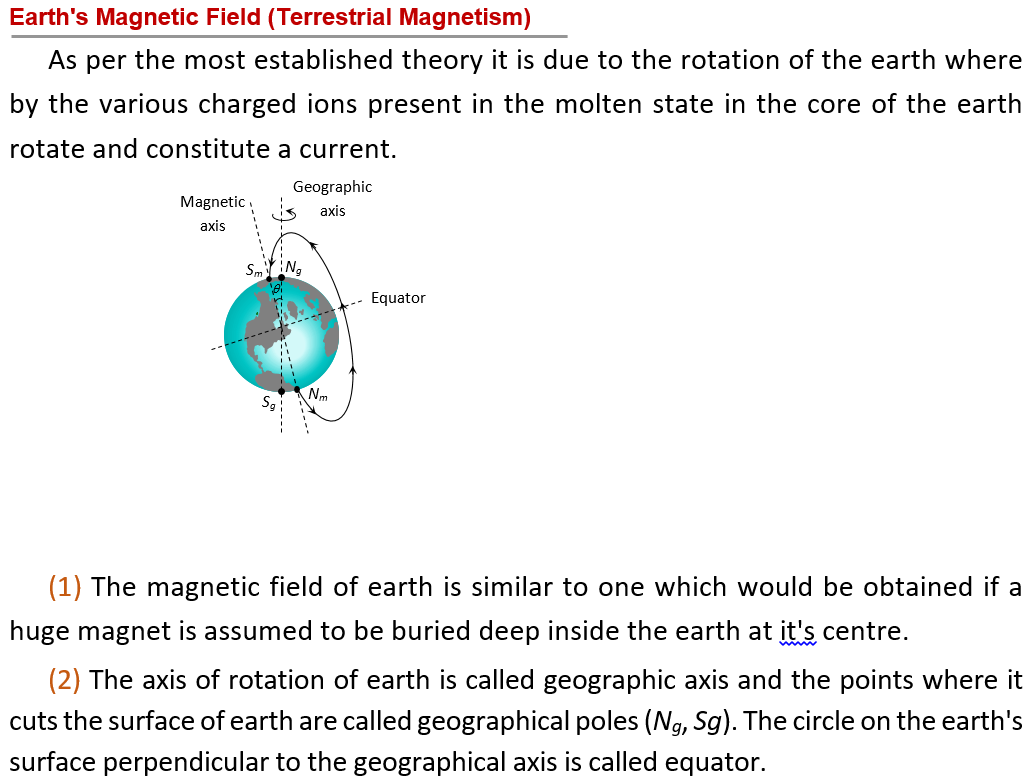
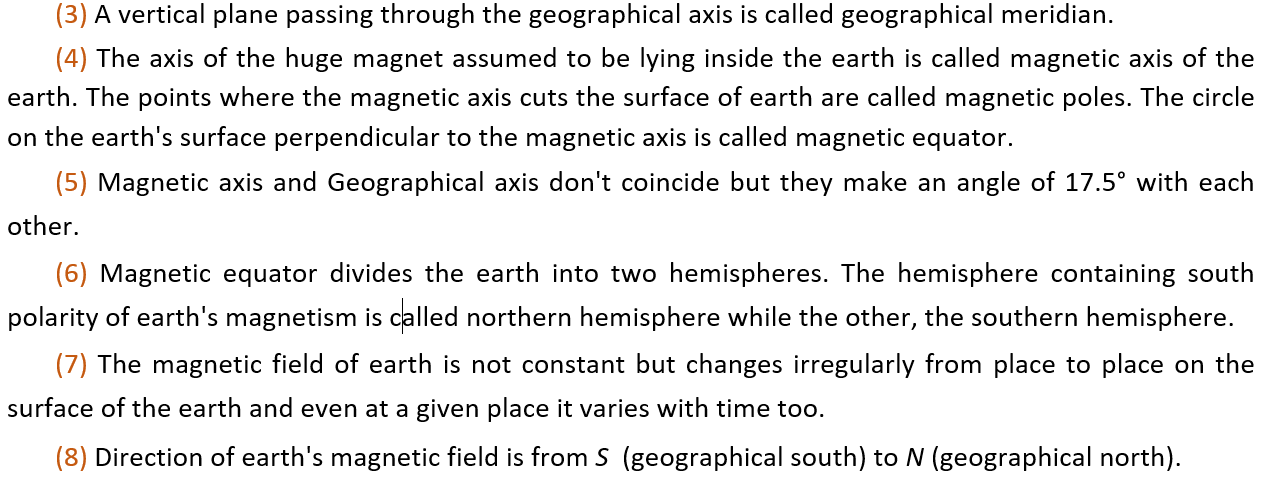
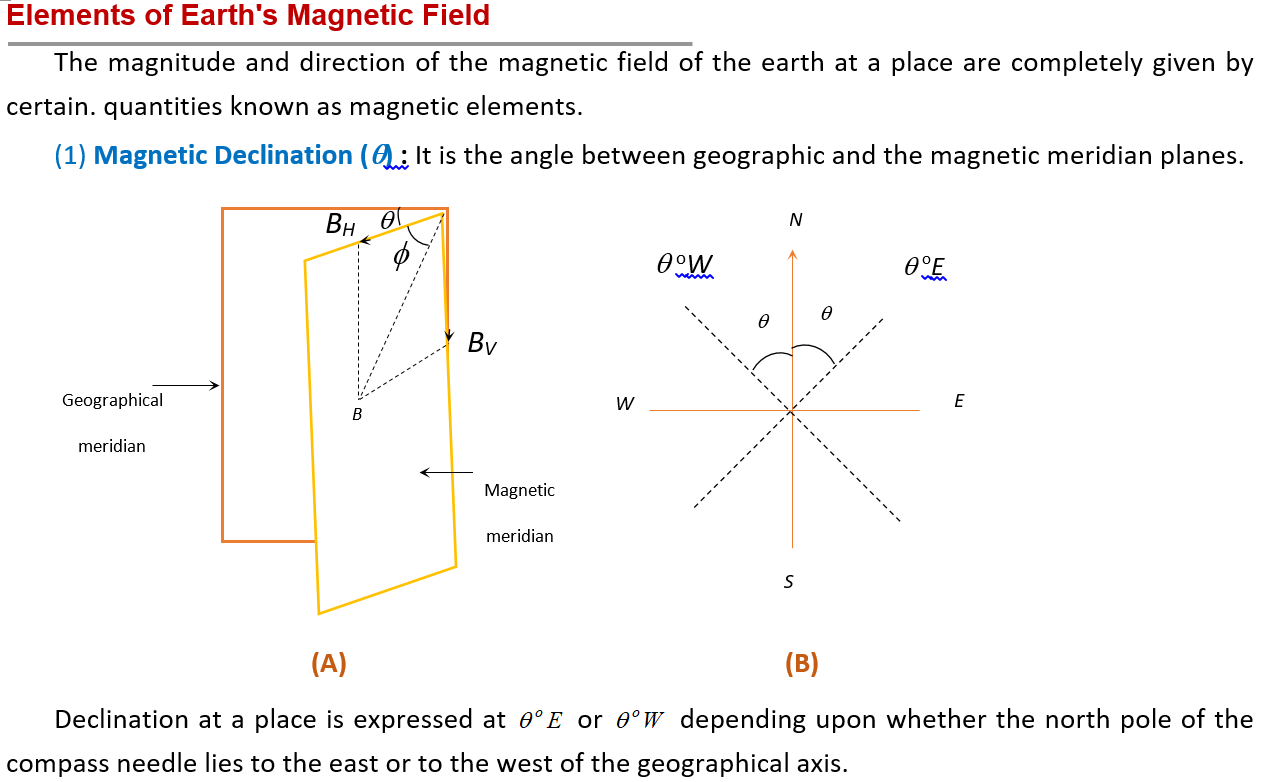
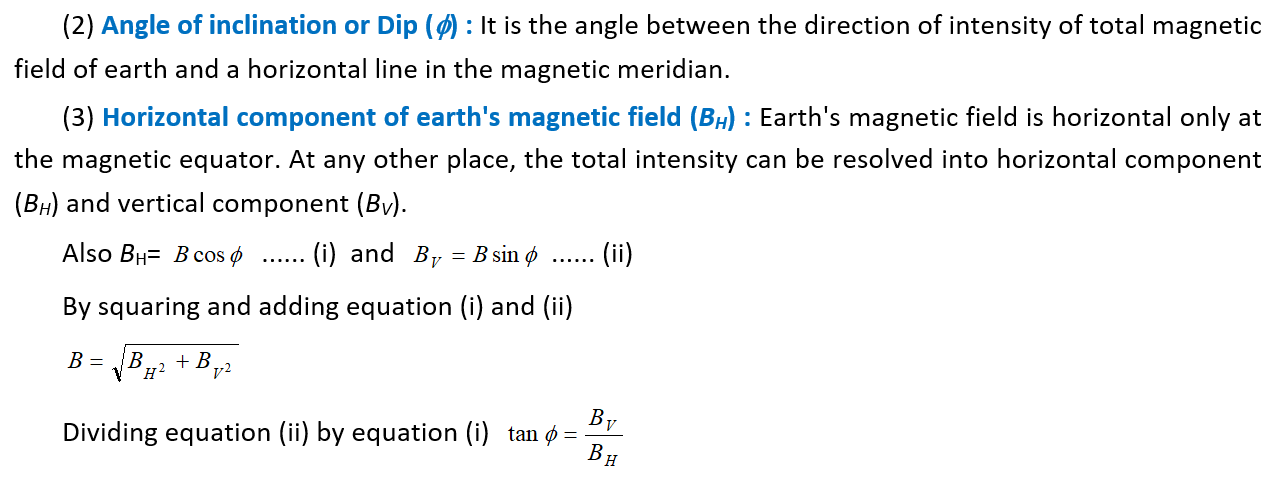
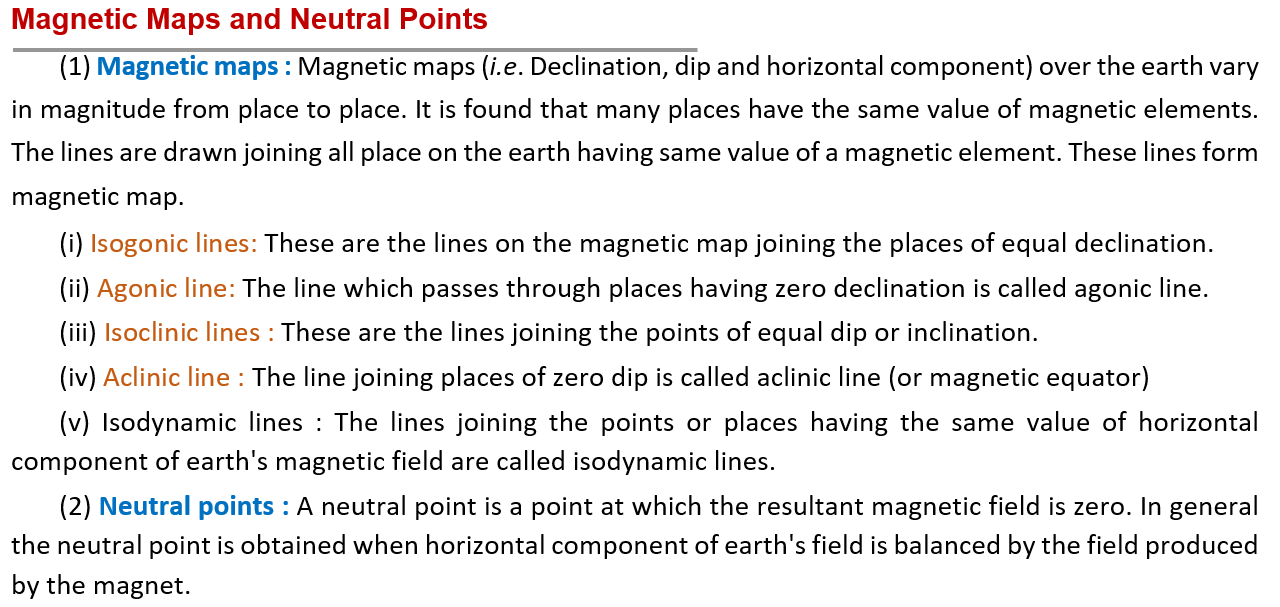
Practice Questions (Basic Level)
1.
At a place, if the earth’s horizontal and vertical components of magnetic fields are equal, then the angle of dip will be
(a) 30{}^\circ
(b) 90{}^\circ
(c) \displaystyle 45{}^\circ
(d) 0°
Ans (c)
2.
At a certain place, the horizontal component of earth’s magnetic field is \sqrt{3}times the vertical component. The angle of dip at that place is
(a) 60{}^\circ
(b) 45{}^\circ
(c) 90{}^\circ
(d) {{30}^{0}}
Ans (d)
3.
The angle between the magnetic meridian and geographical meridian is called
(a) Angle of dip
(b) Angle of declination
(c) Magnetic moment
(d) Power of magnetic field
Ans (b)
4.
At a place the earth’s horizontal component of magnetic field is 0.36\times {{10}^{{-4}}}weber/{{m}^{2}}. If the angle of dip at that place is 60o, then the vertical component of earth’s field at that place in weber/m2 will be approximately
(a) 0.12\times {{10}^{{-4}}}
(b) 0.24\times {{10}^{{-4}}}
(c) 0.40\times {{10}^{{-4}}}
(d) 0.62\times {{10}^{{-4}}}
Ans (d)
5.
The lines joining the places of the same horizontal intensity are known as
(a) Isogonic lines
(b) Aclinic lines
(c) Isoclinic lines
(d) Agonic lines
(e) Isodynamic lines
Ans (e)
6.
A line passing through places having zero value of magnetic dip is called
(a) Isoclinic line
(b) Agonic line
(c) Isogonic line
(d) Aclinic line
Ans (d)
7.
The magnetic compass is not useful for navigation near the magnetic poles because
(a) The magnetic field near the poles is zero
(b) The magnetic field near the poles is almost vertical
(c) At low temperature, the compass needle looses its magnetic properties
(d) Neither of the above
Ans (b)
8.
At a place, the magnitudes of the horizontal component and total intensity of the magnetic field of the earth are 0.3 and 0.6 Oersted The value of the angle of dip at this place will be
(a) 60°
(b) 45°
(c) 30°
(d) 0°
Ans (a)
9.
A compass needle will show which one of the following directions at the earth’s magnetic pole
(a) Vertical
(b) No particular direction
(c) Bent at 45° to the vertical
(d) Horizontal
Ans (a)
10.
The north pole of the earth’s magnet is near the geographical
(a) South
(b) East
(c) West
(d) North
Ans (a)
Practice Questions (JEE Main Level)
Q.1
A long straight conductor is held vertically and a strong current is sent through it in the upward direction. The resultant field to the east of it is (where B is the induction field due to the conductor and \frac{{2a{{H}_{0}}}}{{{{\mu }_{0}}N}} is the horizontal component of the earth’s induction field).
(a) B+{{B}_{0}}
(b) B-{{B}_{0}}
(c) \sqrt{{{{B}^{2}}+{{B}_{0}}^{2}}}
(d) {{B}_{0}}-B
Ans : (a)
Q.2
A circular coil is placed with its axis in the magnetic meridian and a current is passed through it in the clockwise viewed from the south. The field at the center is (where B is the induction field due to the conductor and {{B}_{0}} is the horizontal component of the earth’s induction field).
(a) B+{{B}_{0}}
(b) B-{{B}_{0}}
(c) \sqrt{{{{B}^{2}}+{{B}_{0}}^{2}}}
(d) {{B}_{0}}-B
Ans : (a)
Q.3
A cathode ray tube is placed in the magnetic meridian with cathode to the south and a horizontal magnetic field is applied on the path of cathode rays in the east-west direction. The beam will be deflected
(a) to the east
(b) to the west
(c) vertically upward
(d) vertically downward
Ans : (d)
Q.4
The earth is continuously receiving from outer space very high energy particles called cosmic rays. The main constituents of these rays are protons and alpha particle. An observer on the earth sees them coming
(a) vertically down
(b) from the east
(c) from the west
(d) from the north
Ans : (c)
Q.5
The plane of a vertical circular coil is placed in the magnetic meridian and a strong current is passed through it. The resultant induction field at the center of the coil is (where B is the induction field due to the conductor and {{B}_{0}} is the horizontal component of the earth’s induction field).
(a) B+{{B}_{0}}
(b) B-{{B}_{0}}
(c) B-{{B}_{0}}
(d) {{B}_{0}}-B
Ans : (c)
Q.6
A long, straight conductor is held horizontally in the magnetic meridian and a current is passed through it from south to north. A compass needle placed in the horizontal plane through the conductor to the east of it will be deflected
(a) to the east
(b) to the west
(c) vertically upward
(d) vertically downward
Ans : (d)
Q.7
A vertical straight conductor carries a current vertically upwards A point P lies to the east of it at a small distance and another point Q lies to the west of it at the same distance. The magnetic field at P is
(a) Greater than at Q
(b) Same as at Q
(c) Less than at Q
(d) Greater or less that at Q depending upon the strength of the current
Ans. (a)
8.
A dip needle in a plane perpendicular to magnetic meridian will remain
(a) Vertical
(b) Horizontal
(c) In any direction
(d) At an angle of dip to the horizontal
Ans (a)
9.
A dip circle is at right angle to the magnetic meridian. What will be the apparent dip
(a) 0°
(b) 30°
(c) 60º
(d) 90°
Ans (d)
10.
Due to the earth’s magnetic field, charged cosmic ray particles
(a) Require greater kinetic energy to reach the equator than the poles
(b) Require less kinetic energy to reach the equator than the poles
(c) Can never reach the equator
(d) Can never reach the poles
Ans (c)
11.
Two bar magnets with magnetic moments 2 M and M are fastened together at right angles to each other at their centres to form a crossed system, which can rotate freely about a vertical axis through the centre. The crossed system sets in earth’s magnetic field with magnet having magnetic moment 2M making and angle q with the magnetic meridian such that
(a) \theta ={{\tan }^{{-1}}}\left( {\frac{1}{{\sqrt{3}}}} \right)
(b) \theta ={{\tan }^{{-1}}}\left( {\sqrt{3}} \right)
(c) \theta ={{\tan }^{{-1}}}\left( {\frac{1}{2}} \right)
(d) \theta ={{\tan }^{{-1}}}\left( {\frac{3}{4}} \right)
Ans (c)
12.
At which place, earth’s magnetism become horizontal
(a) Magnetic pole
(b) Geographical pole
(c) Magnetic meridian
(d) Magnetic equator
Ans (d)
13.
A current carrying coil is placed with its axis perpendicular to N-S Let horizontal component of earth’s magnetic field be Ho and magnetic field inside the loop is H. If a magnet is suspended inside the loop, it makes angle \theta with H. Then \theta =
(a) {{\tan }^{{-1}}}\left( {\frac{{{{H}_{0}}}}{H}} \right)
(b) {{\tan }^{{-1}}}\left( {\frac{H}{{{{H}_{0}}}}} \right)
(c) \cos e{{c}^{{-1}}}\left( {\frac{H}{{{{H}_{0}}}}} \right)
(d) {{\cot }^{{-1}}}\left( {\frac{{{{H}_{0}}}}{H}} \right)
Ans (a)
Practice Questions (JEE Advance Level)
Lorem ipsum dolor sit amet, consectetur adipiscing elit. Ut elit tellus, luctus nec ullamcorper mattis, pulvinar dapibus leo.
